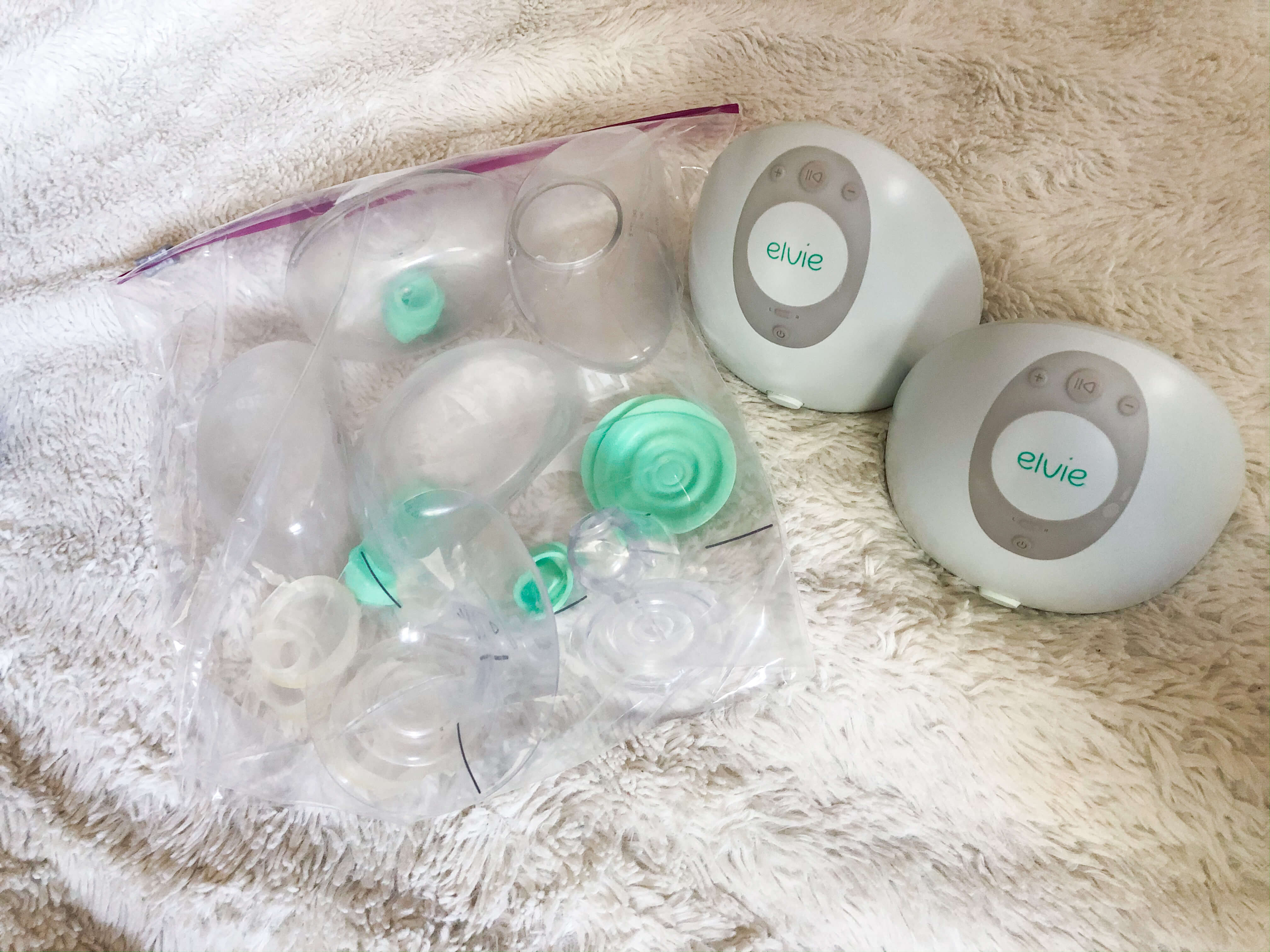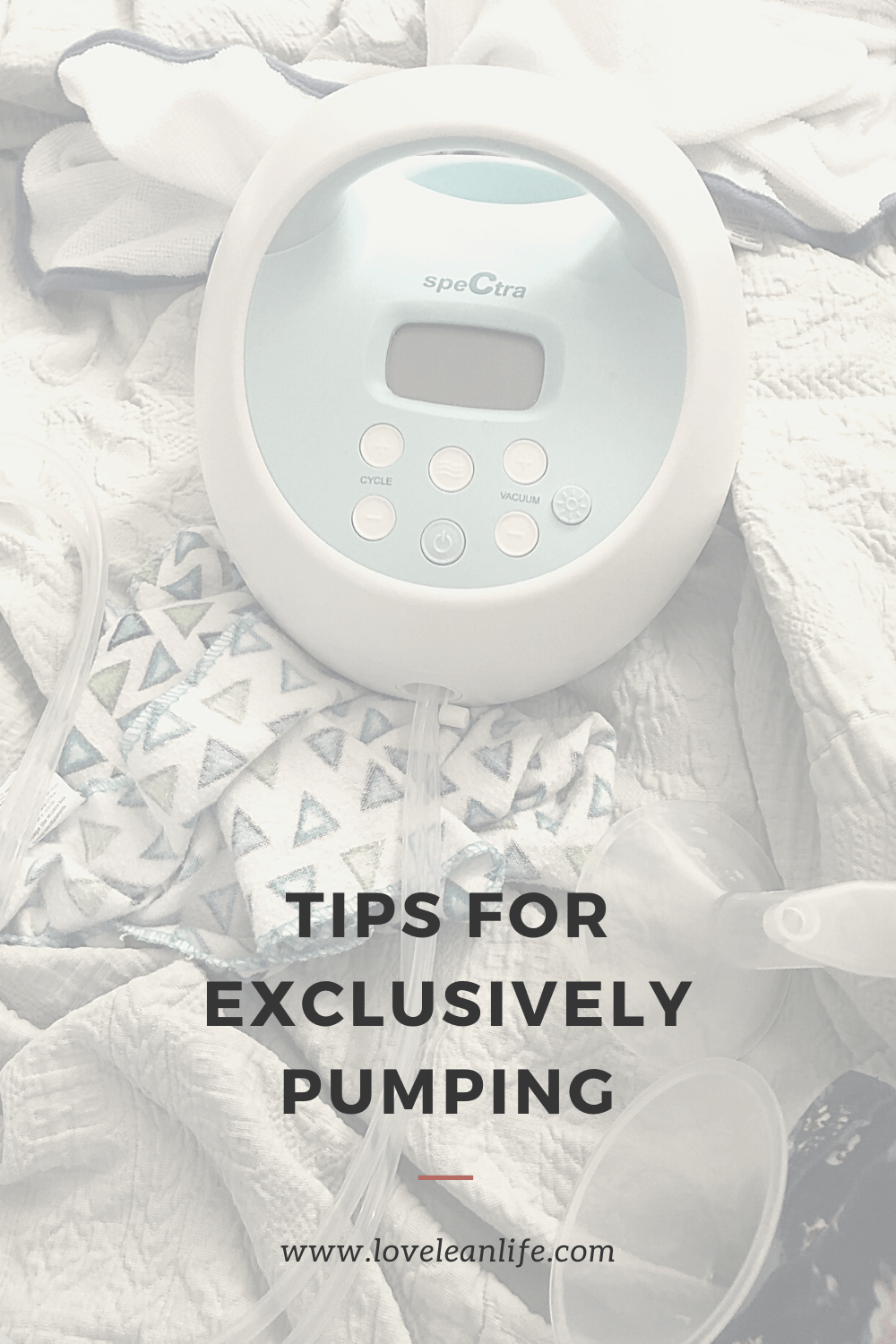Today I’m going to go over a few success tips for those who are exclusively pumping. Even though these tips can work for anyone on their breastfeeding journey, these are especially helpful for the unique journey of exclusively pumping.
There’s a difference between pumping while breastfeeding and exclusively pumping. When you are also breastfeeding while pumping, you are dealing with a different way of regulating the amount of milk that is being made and the amount of time spent on the pump.
How My Breastfeeding Journey Changed
When I first had my twins in September, I came home and was breastfeeding part-time and then pumping the rest of the time.
My pregnancy ended with me developing HELLP Syndrome and so I couldn’t pump for the first eight days of the boy’s life. That made my breastfeeding and my pumping journey a little bit more difficult as well as me feeling I had a low supply right from the beginning.
Why We Stopped Breastfeeding
When they were really little, tandem breastfeeding worked really well. As they got bigger and heavier, my husband would have to help me hold them up to the breast even with a twin breastfeeding pillow below them.
Another big change was that the boys were getting older and they were getting a little more playful and starting to interact with each other while breastfeeding. They were touching each other on the head and then pulling away from the breast. Feeding them both at the same time became really hard.
Breastfeeding just became playtime for them and sometimes lasted for over 40 minutes before they were both done.
After a while, we would breastfeed them one at a time if they were fussy in the middle of the night, but as they got to be better sleepers they didn’t breastfeed at night as much anymore, either. During the day when I was working, I was pumping, so it just turned into me exclusively pumping around the 3 ½ month mark.
We are at seven months now and I am really proud of how long I have stuck with it because I had to go through a lot to get my supply up. It was discouraging in the beginning when I was really sick.
So that is how I went from breastfeeding and pumping to exclusively pumping.
What Does Exclusively Pumping Look Like?
Exclusively pumping means that you’re pumping full time and not feeding the baby from the breast any longer. The baby is still, however, considered breastfed because they are getting milk from the breast. You may be giving your baby breast milk, or as in our case, breast milk and supplementing with formula, as well.
I did not produce enough for two babies to be fuully fed all day long. We still work with a lactation consultant because both breastfeeding and exclusively pumping can be hard and we needed support. That support has been wonderful for us and for our journey.
Hopefully, if you’re an exclusively pumping mama, you take to heart that there’s a lot of people doing this now and this isn’t weird. People think that no one’s doing this or that they’re alone doing this and I really feel like more and more people are exclusively pumping than you think.
I now belong to a couple of Facebook support groups. I also follow a couple of people on Instagram who exclusively pumped. I didn’t even really know people exclusively pumped when I started.
I started looking for options when the boys were not doing as well nursing and it was taking anywhere from 20-40 minutes to feed them at the breast and we still needed to bottle feed them after as well. I questioned who just pumps?! But then I found this great community and a lot of support from it.
There are a lot of people who have helped me through their advice and their expertise because they’ve been doing it for a long time as well. For some, it may be that this is their second or third time exclusively pumping for a baby. They are veterans who have all these tips and tricks, and I’m so happy to have found that community. I want to share some of the stuff that they’ve told me, plus advice from my lactation consultant, and then just what works for me.
Exclusively Pumping Tips
Time Your Pumps to Your Baby’s Feeds
You will want to time your pumps with the number of times your baby is eating over the course of a day. In the beginning, when the boys were first feeding, it was between 8 and 12 times in a day. It was really closer to 12 in the earliest days.
Basically anytime that we were up feeding them, I was up pumping. In the beginning, your supply is based on hormones and also the amount of milk that you take from your body so your body knows to replenish and then replenish again. Then as you go on, your hormones regulate and settle down and your supply is based on demand.
There are a lot of things that affect supply but one of the biggest things that affect it is how frequently you empty the breast and how much you empty it.
If you’re emptying your breasts 8 to 12 times, you’re going to ramp up in production. If you go down in pumps your body is going to adjust the amount of milk down because you’re telling it you don’t need that much.
The best thing for us was to just keep a tally of how often the boys were eating. If it wasn’t convenient for me to pump while they were eating, I would just match the number of times that they ate with how many times I pumped a day. Some days I would just pump every single time we fed them for 10 minutes or 15 minutes but if I couldn’t pump right then, I’d pump later to keep the number matching. That’s how I kept up in the beginning.
Match Cluster Feeding with Pumps
One of the things I did not do because I just got into a routine at first was that I didn’t account for cluster feeding and I didn’t account for growth spurts. Cluster feeding adds sometimes two or three extra sessions a day.
For example, the boys normally went about 1.5 hours to 2 hours between feedings. But during cluster feedings the boys were eating only 10 minutes apart, and then another 30 minutes went by, and they ate again, another 15 minutes went by, and they’re still screaming for food. We would feed them but I wasn’t timing my pumps with those small spurts of rapid feeds.
What it should have been telling me if we were breast breastfeeding is that the boys needed more food and so I should have been pumping more to match that. The same thing with the growth spurt where they might have been eating the same number of times, but they were eating more ounces per session. I didn’t think to account for that in the first couple of months.
Once I met with my lactation consultant they told me to just basically be aware of cluster feeding and growth spurts, and then to add in extra pumps to account for that, and you only do it for as long as the baby is doing that.
So if they cluster feed for two or three days, I would only add two or three sessions extra into those days, I wasn’t doing it from there on out, it was just to match their demand.
Keep up With Growth Spurts
They had a growth spurt in January and that time I knew that as they were eating more, I was supposed to be pumping more. I added an extra two pumps for around three or four days. I can’t remember the exact time but I do remember feeling like they were eating so much and I knew to add a couple additional pumps per day.
Once they normalized the feeds again, we upped the ounces that they were getting. And once that happened, I was also just producing a little bit more at that point. So it just worked out. It makes sense when you think about it as supply and demand. If your baby is cluster feeding or going through a growth spurt, it would be putting more demand on your body.
In the Beginning Pump at Night
I learned this the hard way. In the beginning, you need to pump at night. We don’t really want to go more than five hours between pumps in the very beginning. The maximum you want to go when building your milk supply is probably more like 3 or 4 hours. I pushed it because I was just exhausted and running on fumes.
So a couple of days I would sleep a little bit longer and my husband would get up and do the feeds. But you want to get up in the night and pump when the baby is getting up and eating. When the twins were getting up around every 2.5 hours I was just getting out the pumps too.
But when they started sleeping a little bit longer – five and six hours in the middle of the night, I was not pumping as often. If I went to bed and for some reason, the babies slept longer than anticipated, I wasn’t pumping every three to four hours. This dipped my supply in the early weeks. As they got a bit older it didn’t affect it as much.
I would then set an alarm, and this was something that someone had told me to do, and wake up to pump. I can’t even tell you how stressful that was, hearing that alarm in the middle of the night when you really need sleep. I wouldn’t suggest that. Instead, you can use a trick I’ll cover to make sure you’re still getting up even if your baby isn’t waking you up.
Pay Attention to Your Cycle
One thing that can cause your milk production to dip is the return of your cycle. And throughout the month, whether you’re ovulating or you have a period, it can drop your milk supply. A lot of people find that they can combat that by adding a couple pumps on those days.
If you add pumps and you don’t feel like it helps combat the dip, you can always take a little from your freezer stash you hopefully have built up by then.
A milk stash is good for more than just cycle fluctuations. If you get sick or your body is just not feeling well, you’ll still produce milk, it just may not be as much.
I got the stomach flu and was throwing up for hours and hours and it caused me to pump a lot further apart. For two days, I just didn’t pump as much as normal. So it was really good to have milk to fall back on.
Get Extra Pump Parts
Get extra parts if you can if you plan on pumping for a long time. One of the things that I ordered were a couple extra shields (for my Spectra Breast Pump) and an extra pumping bra and pumping top. I ordered the ones that were my favorite and that were really comfortable. I could have one in the laundry and one that I was wearing. You’re going to spend a lot of time with your pumps on, so it’s really stressful to have no clean pumping bras and to have no clean pumping parts.
If you can get a couple of extra and look at it as an investment for something that you’re going to be doing for months down the line, then it can be really helpful and it can take a little bit of the pressure of always doing laundry and dishes.
I also got extra breast shields for my Elvie Breast Pump. So when they were dirty and when I was tired and I didn’t want to wash them I’d have an extra clean pair and that really helped save time.
Put Your Pump Parts in the Fridge Between Pumps
Speaking of cleaning your pump, when you’re exclusively pumping you can be pumping from six to 12 times a day. On average most people I talked to long term pumped 7-8 times a day.
That’s a lot of times to clean pump parts. The most beautiful thing that someone shared with me was to put your pump parts in a Ziploc bag. After you are done pumping just empty the parts, give it a rinse, and throw it into a Ziploc bag and place in the refrigerator.

This will keep the parts and the milk, anything that is remaining in there, at a safe temperature. You can just put the parts back together to pump again, empty into your bag, put it all back into a Ziploc bag, and put it in the refrigerator over and over. You can do this for an entire day.
Instead of pumping and cleaning it every single time with soap and water and drying it out, you can let it sit in the refrigerator between sessions so that you’re only doing one really deep clean a day.
That really saved my sanity. I had days where I felt like all I did was clean pump parts. When I found the Ziploc bag trick, it saved me so much time. I don’t do it every day but it helps on days I want to save time.
Now I’ve gotten really good at rotating with an extra set of containers. So I just wash one and if one is dirty I have an extra one, which is why I say if you can get a couple of extra parts, it is super helpful.
But if you don’t have extra parts and you need to clean them in between each and it’s driving you crazy because you feel like all you do is watch wash pump parts, just get yourself a Ziploc bag and put it in the refrigerator.
Get The Support of a Lactation Consultant
My lactation consultant has been amazing. I saw one originally who helped us diagnose the boys with lip and tongue ties. Then when I was breastfeeding, they were able to latch and nurse a lot better. I met with a second lactation consultant when I switched to be exclusively pumping because she spoke a lot about that and had a lot of great support for that transition. I just really felt like we were on the same page.
I have seen her a total of two times in person, and then I did a telecall with her this past month, and I can’t tell you the peace of mind I get even if I’m not learning anything new. I think sometimes just having someone sit there and say you’re doing a good job can help you.
I have asked myself if I can really do this so many times, but she always reminds me that I can do it. She’s also helped me navigate any issues like clogged ducts, supplementation, and supporting what is a low supply that I started with.
So how did we find her? We had a list of people covered with our health insurance and then I got a chance to read through their websites and see what they were all about, and how they talked about breastfeeding and pumping. Once I got to her site I really fell in love with how she talked about breastfeeding and pumping. I knew that it was going to be a good match for me.
All insurance companies are different. They differ in how much they cover and what’s included but I really encourage you to check it out if you have the ability to. I know that some lactation consultants don’t take insurance and you can pay for it upfront. They work with you on that, too.
So if you can see a lactation consultant and you want to have that support – that extra encouragement and expertise that reminds you that little changes make big differences – I really encourage you to go see one.
Meet with one or two of them and see who is the best fit for you. But it really has changed how I feel about how I’m doing right on this breastfeeding journey. When you’re at home pumping and things are getting frustrating and you’re looking for answers on the internet, it’s good to actually have someone to reach out to.
When I talk to her I’m brought back and reminded why I’m doing this, the importance of what I’m doing for my family, and how grateful I am that I can even do this in the first place. Seeing that we had a really rough start, it regrounds me and reminds me that while breastfeeding isn’t easy, and exclusively pumping isn’t easy, and raising babies isn’t easy, it’s so worth it.
I think that just having somebody who is there to be your biggest cheerleader while you navigate breastfeeding and pumping is powerful.
Consider Your Mental Health
My Lactation consultant reminds me that there is no right way to do this. You don’t win for having more milk. You win for doing what you can do and being as good of a mom as you can be at the end of the day.
That means that maybe you don’t breastfeed, maybe you don’t pump, maybe this is the end of your journey, or maybe you do it all or some combination.
It looks different for everyone. We talk about things I never considered like my own mental health when breastfeeding and pumping. We’ve talked about if the stressors outweigh the benefit of me pumping. I haven’t gotten to the point where it has, so that’s why I’m still doing this, but it’s wonderful to have someone to ask you those questions.
You need to ask yourself:
Am I more stressed out?
Am I getting too stressed to make this worth doing?
Is there something I can do to make this journey continue working for me?
I really encourage you guys to just seek out some support.
Supplement Carefully
After meeting with a lactation consultant you realize they work with doctors and know your case very personally. They aren’t just giving you advice on a wild guess. I really suggest that you choose supplements for yourself carefully and only with the supervision of a lactation consultant.
There are so many products that are out on the market that are labeled “breastfeeding support,” “herbal support,” and breastfeeding “magic potions.”
I think the best advice I’ve gotten off of the internet about what to take for breastfeeding was someone saying, “Look, if this journey is so important to you, and you really want to know what’s best for your body, talk to someone who knows what they’re talking about.”
Just because something worked for someone else doesn’t mean it’s going to work for you. What some else takes for breastfeeding may not work for your body. And these herbs that people are taking are sometimes really concentrated and high dosage. You shouldn’t just be just dumping those into your body because it worked for someone else.
The same thing with these “magic lactation elixirs.” They are all different and work for different reasons. They address different deficiencies in your body, or different things that your body is struggling with, but to know exactly what you’re struggling with, you should be seeing a doctor and you should be talking to a lactation consultant.

I would never recommend that someone look at what I’m taking for breastfeeding and match it just because it worked for me. If you cannot see a lactation consultant, I would recommend going on to reputable lactation websites like LaLeche League and going over their advice. I would also say to take it very slowly and one at a time if you do it on your own.
Give yourself a couple of days to a week to see if things are working for you. Even with my lactation consultant, we only added one herb at a time to make sure that I was going to add to my life and add to my supply.
We didn’t want to just add in five things and not know which ones actually helped. So supplement carefully. Different people respond to herbs differently. If you can get someone’s helping guidance, you can make the most of the herbs that will really work for you. Herbal support can help you keep your supply up if that’s something you struggle with.
Use Pumping Tools to Empty the Breast Better
There are a lot of tools out there to help you empty the breast better at each pump. I have a hand pump, lactation massagers, and a heating pad.
Those three things allow me to empty the breast better at each pump. When I was just using the pump, I wasn’t emptying the breast as efficiently as I was when I was breastfeeding and I saw a dramatic dip in my supply when I first started to exclusively pump.
I use a heating pad before I pump for just a minute to warm up the breast. This allows for better duct flow and comfort. I use the lactation massager or do hand massage while the pumps are on. This stimulates and helps release the milk from the ducts. I use the hand pump or hand expression after the pump is over for a minute to make sure I was able to better empty the breast and there is almost nothing left in there.

These tools allowed me to bring the supply back up. While it felt like a lot of fuss, once I got into a routine it only added a few minutes to each pump. The goal is to have comfortable, efficient pumping sessions and sometimes that means adding a heating pad or adding in lactation massagers. Maybe it’s hand expressing at the end for you. No matter what combination works for you, just empty the breast as best as you possibly can so your body knows to produce more milk and your supply stays strong.
I know that was a really long blog and thank you for reading it! I hope you enjoy these tips. Let me know if you’re an exclusive pumper! What are things that help you keep your supply up and keep you going on this crazy journey? Where do you find support? And what are the things that have helped you the most? Leave me a comment below.






Leave a Reply
You must be logged in to post a comment.